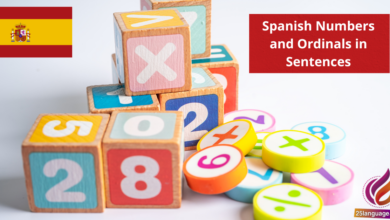The Passive Voice in Spanish

Imagine hearing a captivating story where actions take center stage, regardless of who performs them. That’s the essence of the passive voice in Spanish! In this lesson, we’ll explore how to shift focus from the doer to the action itself, enhancing your conversational skills and understanding of the language. By mastering the passive voice, you’ll express ideas more dynamically and deepen your appreciation of Spanish’s rich and varied structures.
Understanding the Passive Voice: A Guide to Spanish Sentence Structure
The passive voice in Spanish is used to shift focus from the doer of an action to the receiver of that action. In Spanish, this voice is typically formed using the verb “ser” (to be) followed by the past participle of the main verb.The past participle must agree in gender and number with the subject. Here are some important points to consider:
- the structure: ser + past participle + (por + agent).
- Agreement: The past participle must match the subject in gender and number.
- Example: La carta fue escrita por María. (The letter was written by María.)
Another way to express the passive voice in spanish is through the use of “se” to create a reflexive construction. This method is frequently enough used to emphasize the action rather than the doer. The verb is conjugated in accordance with the subject. Key aspects include:
- The structure: Se + verb + subject.
- The verb agrees in number with the subject, not the agent.
- Example: Se venden coches nuevos. (New cars are sold.)
| Spanish Example | structure | English Translation |
|---|---|---|
| La casa fue pintada por el artista. | ser + past participle | The house was painted by the artist. |
| Se hacen preguntas todos los días. | Se + verb + subject | questions are asked every day. |
| Los libros fueron leídos por los estudiantes. | ser + past participle | The books were read by the students. |
| Se prepara la comida en la cocina. | Se + verb + subject | The food is prepared in the kitchen. |
Exploring Passive Constructions: How to Communicate Effectively in Spanish
In Spanish,passive constructions can significantly enhance communication by shifting the focus from the subject performing the action to the action itself or the recipient of the action. There are two primary forms of passive voice in Spanish: the “pasiva refleja” and the “pasiva con ser.” The “pasiva refleja” is formed using the reflexive pronoun “se” followed by the verb conjugated in the third person. This form often emphasizes the action rather than who is performing it. For example:
- Se venden libros. (Books are sold.)
- Se habla español aquí. (Spanish is spoken here.)
On the other hand, the “pasiva con ser” uses the verb “ser” combined with the past participle of the main verb. It’s important to ensure that the past participle agrees with the subject in gender and number. For instance:
| Spanish Example | Rule | English Translation |
|---|---|---|
| La carta fue escrita por María. | Use “ser” + past participle; agree in gender and number. | The letter was written by María. |
| Las canciones fueron cantadas por los niños. | Use “ser” + past participle; agree in gender and number. | The songs were sung by the children. |
Practical Applications of the Passive Voice: Enhancing Your Spanish Skills
The passive voice in Spanish, known as “la voz pasiva,” allows you to focus on the action itself rather than the subject performing it. In Spanish, the passive voice is formed using the verb “ser” followed by the past participle of the main verb. To form the passive voice correctly, ensure that the past participle agrees in gender and number with the subject. For example:
- La carta fue enviada. (The letter was sent.)
- Las cartas fueron enviadas. (The letters were sent.)
Another important aspect is the “se” passive construction, which is often used in conversational Spanish. This structure emphasizes the action while omitting the doer entirely. It is formed by using “se” plus the verb conjugated according to the subject.For instance:
- Se habla español aquí. (Spanish is spoken here.)
- Se vendieron todas las entradas. (All the tickets were sold.)
| Spanish Example | Rule | English Translation |
|---|---|---|
| El libro fue leído. | Forms the passive with “ser” + past participle. | The book was read. |
| Se hizo un examen. | uses the “se” construction for passive voice. | An exam was made. |
| La tarea será completada. | Future passive ideal for indicating upcoming actions. | The homework will be completed. |
Mastering the Passive voice: Techniques and Tips for Spanish Learners
The passive voice in Spanish is formed using the verb ser in conjunction with the past participle of the main verb. This structure allows the focus to shift from the doer of the action to the receiver. With passive constructions, the agent (the doer) can either be included or omitted. As a notable example, a sentence like El libro fue escrito por el autor (The book was written by the author) explicitly mentions the author, while El libro fue escrito (The book was written) omits the agent altogether. To form the passive voice, ensure that you correctly conjugate ser to agree with the subject in number and gender, while the past participle remains invariant, aside from gender agreement in cases of feminine nouns.
- Establish the correct form of ‘ser’:
- fue (was)
- es (is)
- será (will be)
- Add the past participle (which typically ends in -ado for -ar verbs and -ido for -er and -ir verbs):
- hablar → hablado (to speak → spoken)
- comer → comido (to eat → eaten)
| Spanish Example | English Translation | Rule |
|---|---|---|
| La casa fue construida en 2020. | The house was built in 2020. | Use ‘ser’ + past participle |
| El cuadro fue pintado por la artista. | The painting was created by the artist. | Include the agent with ‘por’ |
| Las cartas son entregadas por los carteros. | The letters are delivered by the mailmen. | Present tense ‘ser’ for ongoing actions |
| el libro será leído por millones. | the book will be read by millions. | Future tense ‘ser’ for future actions |
To Wrap It Up
Conclusión de la Lección: La Voz Pasiva en Español
¡Felicidades! Has llegado al final de nuestra lección sobre la voz pasiva en español. Hoy, hemos explorado cómo se forma la voz pasiva, tanto en el tiempo presente como en otros tiempos verbales, y hemos comparado su uso con la voz activa. Recuerda que en español, la estructura de la voz pasiva se enfoca en la acción y el receptor de la misma, lo que te permite enriquecer tus habilidades de comunicación y expresar ideas de manera más matizada.
Hemos aprendido que, para construir frases en voz pasiva, utilizamos el verbo “ser” seguido del participio pasado del verbo principal, y hemos visto ejemplos que ilustran su uso en contextos cotidianos.No olvides que la voz pasiva no solo se utiliza en la escritura formal, sino que también tiene un lugar en conversaciones informales y narrativas.
Te animo a que apliques lo que has aprendido en esta lección.Intenta transformar oraciones activas en pasivas en tus conversaciones diarias o en tus escritos. ¡La práctica es la clave para dominar este concepto! Además, observa cómo los hablantes nativos utilizan la voz pasiva en libros, canciones y películas; aprender de ejemplos reales es una excelente manera de reforzar tu comprensión.
Sigue explorando el español y no dudes en volver a esta lección cada vez que necesites repasar. ¡Sigue adelante, y recuerda que cada paso que das es un avance hacia la fluidez! ¡Buena suerte en tu aprendizaje y hasta la próxima lección!





























